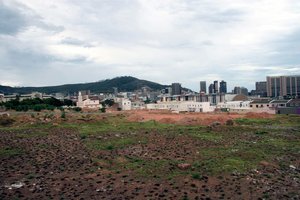Advertisement
Published: February 28th 2010

 Wasteland
Wasteland
This used to be people's homesThe District Six Museum
District Six was once a densely-populated, busy area of
Cape Town. Towards the end of the Nineteenth Century here and the adjoining areas of
Woodstock and
Salt River were working-class areas of Cape Town where all races lived together.
It is of extra interest to me because it was in these areas that my great-grandfather lived and worked and it was on
Constitution Street, in District Six, that my grandfather was born. We are trying to see if the house where my grandfather was born is still there - this is unlikely though.
The first enforced changes to the racial mix of District Six came in 1901 when the colonial government forcibly removed Africans from the area, blaming them for an outbreak of bubonic plague. The real destruction of District Six came, though, when the Apartheid government designated District Six as a “whites only” area and began the process of removing all the residents of the area and bulldozing their homes. Starting in 1968, some 60,000 people were removed and their homes demolished to make way for the redevelopment of the area as a “white” area.
The redevelopment never happened.

 The Former Methodist Chapel Is Now A Museum
The Former Methodist Chapel Is Now A Museum
It was one of the few buildings saved from the bulldozersThe land was just left as wasteland. Even now 85%!o(MISSING)f the land is grass, weeds and car parks. Fifteen years after the end of apartheid only 24 houses have been built to re-house the people who were evicted.
When the houses were demolished whole streets disappeared. The street where my grandfather was born,
Constitution Street, was a major road through the area and is still on the maps. I don't know if any of the houses will still be standing, though.
When the government flattened peoples' homes they left the churches and mosques standing. A Methodist chapel remained even though it's entire congregation had been moved away. This chapel is now the
District Six Museum. Admittedly, the museum has an extra attraction for us because we are trying to find out what happened to the house on Constitution Street, but this museum is well worth a visit. It contains artefacts recovered from District Six and donated by former residents, photographs and accounts of the lives of people who lived in the area. The floor area is mostly covered with a large map of the area where former residents have marked on where their homes were and there
is the moving "name cloth" signed by former residents.
Advertisement
Tot: 0.063s; Tpl: 0.009s; cc: 6; qc: 24; dbt: 0.0283s; 1; m:domysql w:travelblog (10.17.0.13); sld: 1;
; mem: 1.1mb

 Wasteland
Wasteland
 The Former Methodist Chapel Is Now A Museum
The Former Methodist Chapel Is Now A Museum